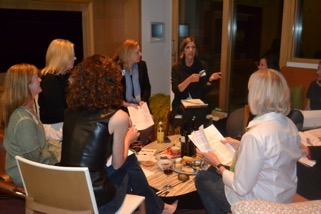‘Social Capital’ and the Value of Roundtable Discussion
By Stephanie Edelman Zarate
The Policy Circle co-founder Sylvie Légère recently gave a talk in Washington, DC, to women participating in the National Excellence in Public Service conference that brought together organizations such as the Lugar Series that encourages women to run for local, state and national elective and appointed offices.
In her remarks, Sylvie spoke about the importance of “social capital,” which in The Policy Circle is built through “the face-to-face conversations with other women, building a community that forges bonds and builds trust” – and this social capital is crucial for a community to get engaged.
So what is “social capital”?
The concept of social capital is often traced to Harvard political scientist Robert Putnam and his writings on community and civic participation. Putnam’s influential book Bowling Alone examined the decline of civic engagement in America, including the decline of political engagement (voting, political knowledge, political activism, etc.). In earlier writings, he defined “social capital” as “connections among individuals – social networks and the norms of reciprocity and trustworthiness that arise from them. In that sense social capital is closely related to what some have called ‘civic virtue.’ The difference is that ‘social capital’ calls attention to the fact that civic virtue is most powerful when embedded in a sense network of reciprocal social relations. A society of many virtuous but isolated individuals is not necessarily rich in social capital.”
In the Policy Circle, the Roundtable Discussion Model is the part of our framework that allows us to build that social capital and get everyone engaged. By having our facilitators inviting everyone to speak once if they choose to, we allow introverts as well as extroverts to contribute. As Susan Cain writes in her book Quiet: The Power of Introverts in A World That Can’t Stop Talking, “Any time people come together in a meeting, we’re not necessarily getting the best ideas; we’re just getting the ideas of the best talkers.”
Putnam emphasized that social capital was extremely important for human well-being and has the power to profoundly impact our lives. He also distinguished between bonding and bridging:
Bonding in social capital “is referred to as social networks between homogenous groups” and “bridging in social capital is referred to as social networks between socially heterogeneous groups. Bridging allows different groups to share and exchange information, ideas and innovation and builds consensus among the groups representing diverse interests.”
In The Policy Circle, we’re able to provide the bonding aspect of social capital through our Circle meetings and other forms of engagement, but the bridging happens through our sharing of ideas from other organizations and groups. This echoes one of AEI’s Arthur Brooks’ tips from The Conservative Heart:
“#5 – Go where you’re not welcome. Get out of your comfort zone! Attract people who don’t see things the same way and try to enlist them to the cause. Conservatives must be more than a motivated minority. Expand your horizons, and engage with true believers, persuadables, and even hostiles.”
What are ways that you can develop and enhance social capital for yourself or your Circle? Next time you Circle Up we encourage you to think about how you can explore bonding and bridging in social capital in your community!
